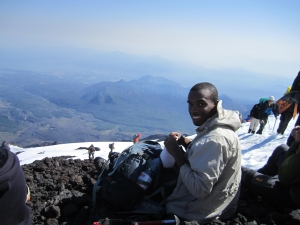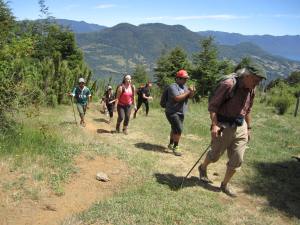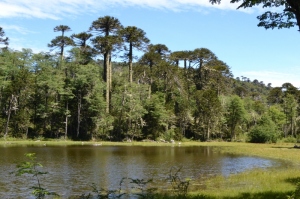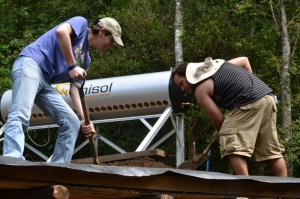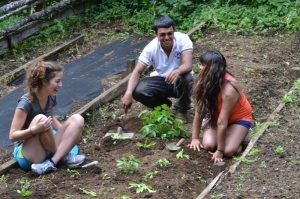by Lindsay Cox
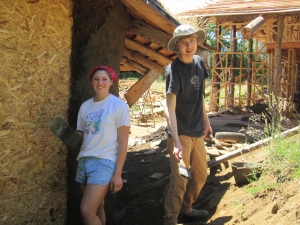 I don’t believe we’ll soon forget our first day of mud-slinging (among other work) at the building site in Los Riscos, the future home of a Waldorf school run by Pucon resident and environmentalist Jerry Laker. Jorge and Leo, our mentors and builders, made it look so easy – scoop up a handful of the sand, clay, straw and manure mixture, take aim at a spot on the wall, and release! Once stuck on the wall, smooth with a spatula and repeat. Keep repeating, and you’ll soon have a smooth surface that will be ready for painting once dry. This looked easy, so we took aim and fired with confidence; our mudballs flopped onto the floor like sad, somewhat stinky pancakes. But with some patience from Jorge and Leo, and over the course of the next couple of hours, our hands became acquainted with the texture, elasticity and unique nature of our building material. Slinging the mixture on the wall became easier; we acquired just the right touch for smoothing so that our recently completed work would not cake off. Both students and teachers reached a rhythm, a harmony with our surroundings and our teammates; it seems we reached the point where we could just begin to put our fingers on the pulse of sustainable building.
I don’t believe we’ll soon forget our first day of mud-slinging (among other work) at the building site in Los Riscos, the future home of a Waldorf school run by Pucon resident and environmentalist Jerry Laker. Jorge and Leo, our mentors and builders, made it look so easy – scoop up a handful of the sand, clay, straw and manure mixture, take aim at a spot on the wall, and release! Once stuck on the wall, smooth with a spatula and repeat. Keep repeating, and you’ll soon have a smooth surface that will be ready for painting once dry. This looked easy, so we took aim and fired with confidence; our mudballs flopped onto the floor like sad, somewhat stinky pancakes. But with some patience from Jorge and Leo, and over the course of the next couple of hours, our hands became acquainted with the texture, elasticity and unique nature of our building material. Slinging the mixture on the wall became easier; we acquired just the right touch for smoothing so that our recently completed work would not cake off. Both students and teachers reached a rhythm, a harmony with our surroundings and our teammates; it seems we reached the point where we could just begin to put our fingers on the pulse of sustainable building.
Over three days of hands-on volunteer work (not only mud-slinging, but also hauling rock and sand, carpentry, and equipment repair) and conversations with our new friends in Los Riscos, our students got a first-hand peek at what it means to be a sustainable “do-it-yourselfer”. Use what is at hand (old bottles, cans and bags were used to fill interiors of walls), use what is local (sand, clay and manure), and use simple building methods that are accessible to people who are neither carpenters nor contractors. In this way, great things can be achieved – the old scheme is broken. What we assumed was unattainable without someone else’s specialized equipment and knowledge, as well as significant financial resources, really IS possible to do ourselves – sustainably, in harmony with the surrounding landscape and the local community, and in cooperation with others who share the same vision. We don’t know what path our students will follow down the road, but we do know that their experiences at Los Riscos will have an impact. Not only that, but our students have made their own contribution, one that goes beyond the walls they helped build – in traveling from halfway across the globe to spend their time volunteering at a sustainable school, they are sending a powerful message that our planet, and our future, are worth the effort.
Follow all the adventures from the 2014 Landmark College Study Abroad Program in Chile by subscribing to this blog now.
